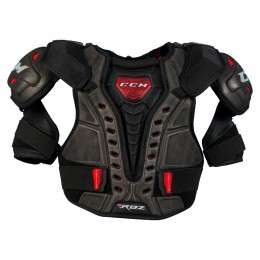Archive for the FAQ Category
What to Look for in a Goalie Stick
- When choosing a goalie stick, there are some important features to look for when trying to identify the right stick.
- Paddle Height- One of the most common problems that we see in young goaltenders is incorrect paddle height on their stick. It is important to have a good “balance” when you are crouched in the butterfly position. Too often young goalies have paddles that are too large, which throws off their overall balance, and exposes them to bigger rebounds and more areas for the shooter to score. The below picture of Tukka Rask is exactly how you want to be “balanced” when you’re in net. Tuukka gets very low in his stance, so he uses a much smaller paddle than other goalies. There is no uniform measurement for having the properly sized goalie stick, so it is essential to identify what stick height best fits your style of play.
- Weight- The weight of a goalie stick is another overlooked aspect, especially in younger goaltenders. Many times younger goalies have difficulty handling heavier wood sticks. Composite sticks are much lighter, and we typically recommend them to anyone just starting out. For goalies playing at the high school level or higher, we recommend foam core wood sticks. They are slightly heavier than composite sticks, but goalies typically have a much better “feel” for the puck because of the wood construction.
- Feel- Typically, foam core wood goalie sticks generate the best “feel” for the puck. The wood construction allows for a better handle on the puck, and works to “deaden” shots on net. Conversely, composite sticks generate a strong bounce or deflection because of the materials that make up the stick.
- It is important for every goalie to find the best combination of height, weight and feel to find the perfect stick for your game. You shouldn’t have to sacrifice one aspect to achieve another. Make sure to consult the goalie experts at Sports Etc. before your next purchase!
Hockey Parent’s Guide to Fitting Shoulder Pads
In the physical nature of hockey, it is important to have properly fitting shoulder pads. One of the common tendencies when fitting shoulder pads is to look at the shoulder caps themselves. While this is important, there are many other factors to look at when evaluating the fit of a shoulder pad. Below are some of the key features of a good shoulder pad:
- Shoulder Caps- Shoulder caps come in many different shapes and sizes. One of the common misconceptions is that a bigger shoulder cap is more protective. Bigger is not necessarily better. Many shoulder pads now come with a more tapered fit around the shoulder, but offer the same level of protection. You want to make sure the shoulder caps sit directly on top of the shoulders. A shoulder pad that is too large, will slide down the arms of the player and will be more susceptible to shifting around. One that is too small will not properly cover the shoulder.
- Clavicle Protection- Many shoulder pads do not come with a reinforced clavicle protection, so it is important to make sure that there is a reinforced piece of protection over the collar bone. A good shoulder pad will offer this protection.
- Upper Arm Protection- This part of the shoulder pad is often adjustable, and can be slid up and down to offer the best overall protection for the upper arm. The arm of the shoulder pad should meet the top of the elbow pad to ensure the most quality fit.
- Sternum Protection- One of the often overlooked pieces of protection is the sternum. A quality shoulder pad will contain a reinforced piece of padding directly over the sternum area. Many cheaper shoulder pads will offer limited or no protection through this area of the chest.
- Spine Protection- Another extremely important piece of the shoulder pad is the spinal protection. A quality shoulder pad will have a reinforced padding all the way down the spinal cord to ensure protection in an extremely sensitive area of the body. A cheaper shoulder pad will not contain this piece of padding.
Fit Instructions- You want to make sure that the shoulder caps sit directly over the shoulder bone, fully covering the collar bone on each side. The upper arm should meet the top of the elbow pad to fully cover the arm. The shoulder pad should also cover down to at least the middle of the stomach in the front, and midway down the back, where it should meet the hockey pant for full back and kidney protection.
How Do You Properly Fit Hockey Skates?
When it comes to a hockey player’s performance, properly sized skates are a very important piece of the game. When a player wears a skate that is not sized correctly or is uncomfortable, it can cause blisters & discomfort. To avoid this, you want to ensure your skates are properly sized.
Having strong ankle support, with good stability, is vital to a correctly sized pair of skates. You want your skates to have a solid exterior to protect your feet from other skates & pucks. A strong boot also provides proper alignment so your ankles do not lack support. Usually, your skates should be about 1 ½ sizes smaller than your normal shoe size. As you try on skates, try to wear socks similar to the ones you would wear while playing hockey.
When fitting youth skates, you want to be able to place a finger in the middle of the heel of your foot & the boot. This allows room for growth in the skates. Next, kick your heel into the back of your boot. Keeping your foot flat on the ground, tightly lace your skates so your foot stays firmly in place.
Walk around in your skates to check the comfort of them. It is important to focus on a few things. You want to make sure that your heel is laying flat and not moving around when you walk. You should have a little bit of space in the toe (if your toe is lightly brushing the toe box that is okay). This ensures that the skate is the proper length. Likewise, it is also important to make sure that the width is not too tight or too loose. Skates come in many different widths depending on the make of the skate. The skate should fit snugly, but should not feel like it’s digging into the side of the foot.
Most skates are now heat moldable, so the break-in process has become much easier, but it can take a few wears to break in your skates.
For more questions on properly fitting your skates, you can contact us at 781-646-1600 or stop by our Arlington store.











 Location:
Location:  Phone:
Phone:  Email: info@sportsetc.net
Email: info@sportsetc.net